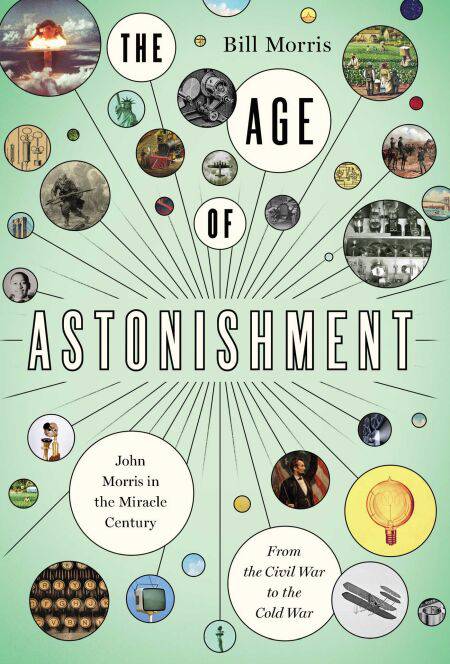
- Retrait gratuit dans votre magasin Club
- 7.000.000 titres dans notre catalogue
- Payer en toute sécurité
- Toujours un magasin près de chez vous
- Retrait gratuit dans votre magasin Club
- 7.000.0000 titres dans notre catalogue
- Payer en toute sécurité
- Toujours un magasin près de chez vous
The Age of Astonishment EBOOK
John Morris in the Miracle Century—From the Civil War to the Cold War
Bill Morris
Ebook | Anglais
21,24 €
+ 21 points
Format
Description
An acclaimed journalist and novelist makes history personal, painting a rich and vivid portrait of the time when America become modern by tracing the life of one man who lived through it.
It all began with a black-and-white family snapshot of a distinguished elderly gentleman with a fine head of spun-sugar hair. He was wearing round, tortoise-shell glasses, a three-piece suit and an expression of delight mixed with terror, for on his right knee he was balancing a swaddled infant with a bewildered look. The baby is Bill morris, the man is his father’s father, John Morris.
That photo, taken in November 1952, the month the United States detonated the first hydrogen bomb, a weapon a thousand times more powerful than the atom bombs that incinerated Hiroshima and Nagasaki. Three years later, John Morris died at the age of 92. Bill has no memories of the man, but even as a boy he found himself marveling at the changes John must have witnessed and experienced in his long lifetime.
He was born into a slave-owning Virginia family during the Civil War, and he died at the peak of the Cold War. At the time of his birth, the dominant technologies were the steam engine and the telegraph. He grew up in a world lit by kerosene and candles, he traveled by foot and horseback and wagon and drank water hauled from a well. He would live through Reconstruction, women’s suffrage, Prohibition, the Great Depression, two world wars, the Korean War and the advent of nuclear weapons.
Though he was from a slave-owning family, he changed his views as he grew into adulthood, and would unhappily witnessed the horrors of Jim Crow and work against it. Fluent in German, he would witness Hitler’s rise to power, just one of the unimaginable occurrences of his time that suddenly became all-too-real.
Deep in the Bible Belt, John was agnostic, perhaps even atheist, and held remarkably progressive beliefs on race relations, child rearing, women’s rights and religious freedom. He married an Irish Catholic from upstate New York at a time when Catholics, Jews and Yankees were not warmly welcomed in the South. And in that traditionally bellicose region, he was a life-long pacifist. He was, in a word, a misfit, but one whose story embodies a pivotal generation in American history.
An acclaimed journalist and novelist, Bill Morris makes history personal in The Age of Astonishment, painting a rich and vivid portrait of the time when America become modern by tracing the life of one man who lived through it.
It all began with a black-and-white family snapshot of a distinguished elderly gentleman with a fine head of spun-sugar hair. He was wearing round, tortoise-shell glasses, a three-piece suit and an expression of delight mixed with terror, for on his right knee he was balancing a swaddled infant with a bewildered look. The baby is Bill morris, the man is his father’s father, John Morris.
That photo, taken in November 1952, the month the United States detonated the first hydrogen bomb, a weapon a thousand times more powerful than the atom bombs that incinerated Hiroshima and Nagasaki. Three years later, John Morris died at the age of 92. Bill has no memories of the man, but even as a boy he found himself marveling at the changes John must have witnessed and experienced in his long lifetime.
He was born into a slave-owning Virginia family during the Civil War, and he died at the peak of the Cold War. At the time of his birth, the dominant technologies were the steam engine and the telegraph. He grew up in a world lit by kerosene and candles, he traveled by foot and horseback and wagon and drank water hauled from a well. He would live through Reconstruction, women’s suffrage, Prohibition, the Great Depression, two world wars, the Korean War and the advent of nuclear weapons.
Though he was from a slave-owning family, he changed his views as he grew into adulthood, and would unhappily witnessed the horrors of Jim Crow and work against it. Fluent in German, he would witness Hitler’s rise to power, just one of the unimaginable occurrences of his time that suddenly became all-too-real.
Deep in the Bible Belt, John was agnostic, perhaps even atheist, and held remarkably progressive beliefs on race relations, child rearing, women’s rights and religious freedom. He married an Irish Catholic from upstate New York at a time when Catholics, Jews and Yankees were not warmly welcomed in the South. And in that traditionally bellicose region, he was a life-long pacifist. He was, in a word, a misfit, but one whose story embodies a pivotal generation in American history.
An acclaimed journalist and novelist, Bill Morris makes history personal in The Age of Astonishment, painting a rich and vivid portrait of the time when America become modern by tracing the life of one man who lived through it.
Spécifications
Parties prenantes
- Auteur(s) :
- Editeur:
Contenu
- Nombre de pages :
- 304
- Langue:
- Anglais
Caractéristiques
- EAN:
- 9781643137056
- Date de parution :
- 04-04-22
- Format:
- Ebook
- Protection digitale:
- Adobe DRM
- Format numérique:
- ePub

Les avis
Nous publions uniquement les avis qui respectent les conditions requises. Consultez nos conditions pour les avis.






